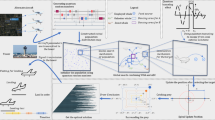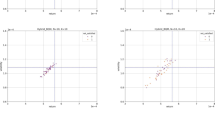Abstract
In this article, we tackle the aircraft load optimization problem using classical optimization algorithms and optimization algorithms with QUBO (quadratic unconstrained binary optimization) formulation to run on quantum annealers. The problem is realistic based on plans of a certain aircraft model, the Airbus A330 200F, and can be adapted to other models from other manufacturers. We maximize a characteristic of the combination of containers (unit load device, ULD) to be transported, be it weight, volume, profit, or another, while complying with necessary parameters related to the flight such as the balance of the center of gravity as well as stress in the structure. Finally, examples of the results of different runs on QUBO in the D-Wave simulator are presented.












Similar content being viewed by others
Explore related subjects
Discover the latest articles and news from researchers in related subjects, suggested using machine learning.Data availibility
No datasets were generated or analysed during the current study.
Notes
The quasi-binary representation of a number \( c \) is obtained by taking \( M \) Boolean variables \( y_k \) with \( M = \lfloor \log _2(c) \rfloor \) for its binary expansion in which the coefficient of the most significant term \( y_M \) is changed from \( 2^M \) to \( (c + 1 - 2^M) \). Therefore, the range of values that can be represented with the Boolean variables goes from 0 to \( c \). In this representation, values smaller than \( c \) can have more than one valid configuration.
References
IATA-McKinsey study shows imbalanced aviation value chain. https://www.iata.org/en/pressroom/2022-releases/2022-12-06-02/. Accessed 05 June 2023
Airlines cut losses in 2022; return to profit in 2023. https://www.iata.org/en/pressroom/2022-releases/2022-12-06-01/. Accessed 05 June 2023
Passenger demand recovery continued in December 2022 & for the full year. https://www.iata.org/en/pressroom/2023-releases/2023-02-06-02/. Accessed 05 June 2023
Air cargo demand decline slows in April. https://www.iata.org/en/pressroom/2023-releases/2023-05-31-01/. Accessed 05 June 2023
Airbus: airbus quantum computing challenge—problem statement n\(^\circ \)5 - aircraft loading optimisation. Airbus quantum computing challenge problem statement n\(^\circ \)5 aircraft loading optimisation. Accessed 22 July 2021
Preskill, J.: Quantum computing in the NISQ era and beyond. Quantum 2, 79 (2018)
Kadowaki, T., Nishimori, H.: Quantum annealing in the transverse Ising model. Phys. Rev. E 58(5), 5355 (1998)
Kato, T.: On the adiabatic theorem of quantum mechanics. J. Phys. Soc. Jpn. 5(6), 435–439 (1950)
Farhi, E., Goldstone, J., Gutmann, S., Sipser, M.: Quantum computation by adiabatic evolution. arXiv preprint arXiv:quant-ph/0001106 (2000)
Bushnell, D.M.: Survey of quantum technologies in aerospace (2023). IEEE
Rosch-Grace, D., Straub, J.: Analysis of the potential benefits from using quantum computing for aerospace applications. In: 2022 IEEE Aerospace Conference (AERO), pp. 1–6 (2022). IEEE
Stollenwerk, T., O’Gorman, B., Venturelli, D., Mandra, S., Rodionova, O., Ng, H., Sridhar, B., Rieffel, E.G., Biswas, R.: Quantum annealing applied to de-conflicting optimal trajectories for air traffic management. IEEE Trans. Intell. Transp. Syst. 21(1), 285–297 (2019)
Makhanov, H., Setia, K., Liu, J., Gomez-Gonzalez, V., Jenaro-Rabadan, G.: Quantum computing applications for flight trajectory optimization. arXiv preprint arXiv:2304.14445 (2023)
Pilon, G., Gugole, N., Massarenti, N.: Aircraft loading optimization–QUBO models under multiple constraints. arXiv preprint arXiv:2102.09621 (2021)
Çela, E., Punnen, A.P.: Complexity and polynomially solvable special cases of QUBO. In: The Quadratic Unconstrained Binary Optimization Problem: Theory. Algorithms, and Applications, pp. 57–95. Springer, Cham (2022)
Lucas, A.: Ising formulations of many NP problems. Front. Phys. 2, 5 (2014)
Coffey, M.W.: Adiabatic quantum computing solution of the Knapsack problem. arXiv preprint arXiv:1701.05584 (2017)
Karp, R.M.: Reducibility among combinatorial problems. Springer, Cham (2010)
D-Wave systems: welcome to D-Wave system documentation. https://docs.dwavesys.com/docs/latest/c_gs_1.html. Accessed 13 Oct 2023
Gurobi optimization, LLC: Gurobi optimizer reference manual (2023). https://www.gurobi.com
D-Wave systems Inc.: D-Wave hybrid release 0.6.10. https://docs.ocean.dwavesys.com/_/downloads/hybrid/en/latest/pdf/ (2023)
Configuring access to Leap’s solvers—ocean documentation 6.7.1. Accessed 7 Dec 2023
D-Wave systems Inc.: QPU-specific physical properties: advantage-system6.3 user manual. (2023)
Author information
Authors and Affiliations
Contributions
All the authors contributed equally to this work.
Corresponding author
Ethics declarations
Conflict of interest
The authors declare no competing interests.
Additional information
Publisher's Note
Springer Nature remains neutral with regard to jurisdictional claims in published maps and institutional affiliations.
Appendices
Appendix A ULDs compatible with the model
Given the diverse fuselage radii observed in different cargo aircraft models, despite the standardization of container dimensions and pallet base size, a notable variety of ULDs exists, setting them apart from sea cargo containers. The A330-200F model distinguishes itself by accommodating nearly all existing ULD types due to its modern design. In Appendix A, Tables 2 and 3 enumerate the selected containers and pallets for this model, chosen based on their widespread usage.
Appendix B Shear force calculations
Shear force is caused by the weight of the ULDs and is calculated assuming the aircraft is static and level. The lower decks are modeled to be continuously supported by the same beams, which means that the load distribution is simply summed to the main deck. ULDs are modeled as uniformly distributed loads along their length in the direction of the beam, as shown in Fig. 4.
The discrete model calculates the following equations:
For the front of the wings:
where \(a_0\) is the point on the main deck closest to the cabin, x goes from \(a_0\) to the point of support, and q(x) is the linear load density.
For the cargo loaded to the back of the wings:
where \(a_1\) is the point on the main deck furthest from the cabin, \(x^{'}\) goes from \(a_1\) to the point of support, and \(q(x^{'})\) is the linear load density.
The integrals are calculated as a Riemann sum with partitions of one inch over the length of the beams:
for the front beam, and
for the rear beam.
When ULDs are uniformly distributed loads, the sum gives exact results and will continue to do so if the load distribution is any step function with steps in whole inches.
Rights and permissions
Springer Nature or its licensor (e.g. a society or other partner) holds exclusive rights to this article under a publishing agreement with the author(s) or other rightsholder(s); author self-archiving of the accepted manuscript version of this article is solely governed by the terms of such publishing agreement and applicable law.
About this article
Cite this article
Gatti, L., Sotelo, R., Orihuela, J. et al. QUBO formulation for aircraft load optimization. Quantum Inf Process 23, 355 (2024). https://doi.org/10.1007/s11128-024-04569-6
Received:
Accepted:
Published:
DOI: https://doi.org/10.1007/s11128-024-04569-6




